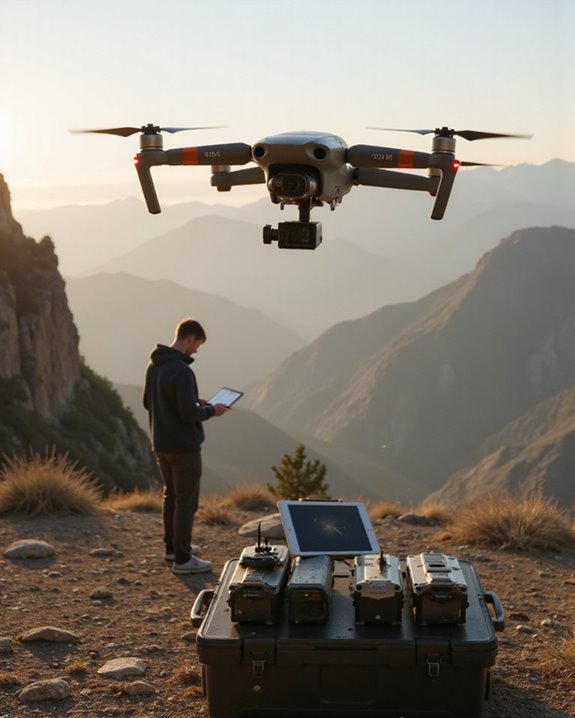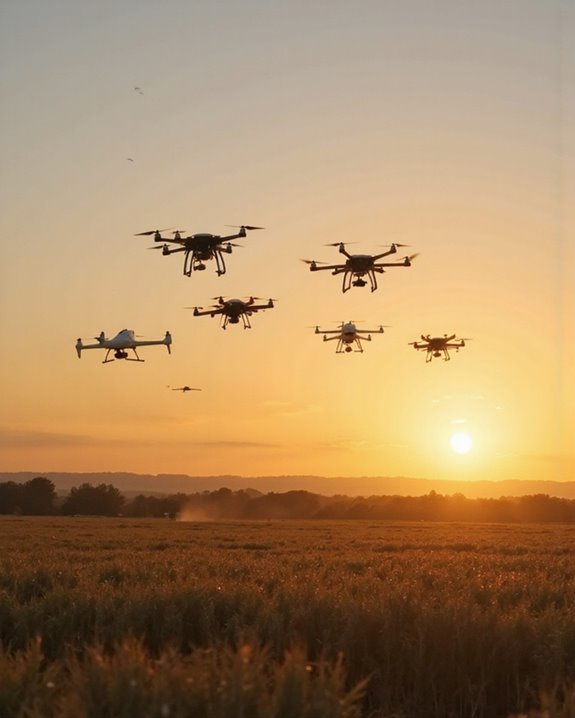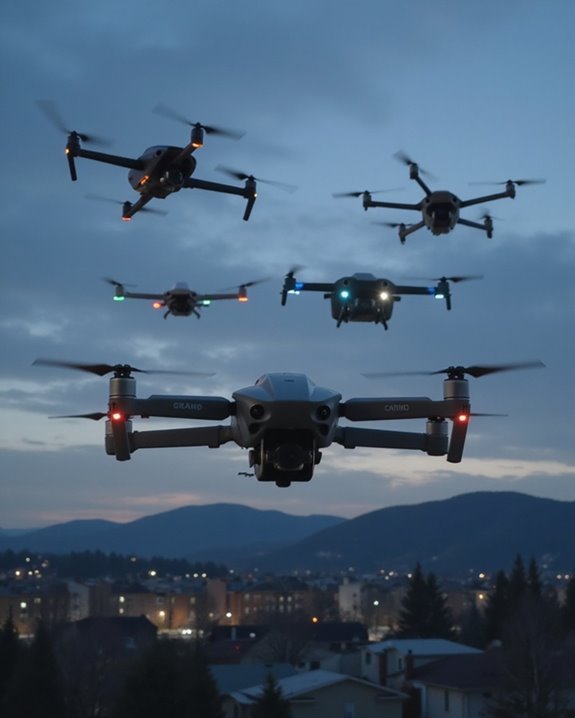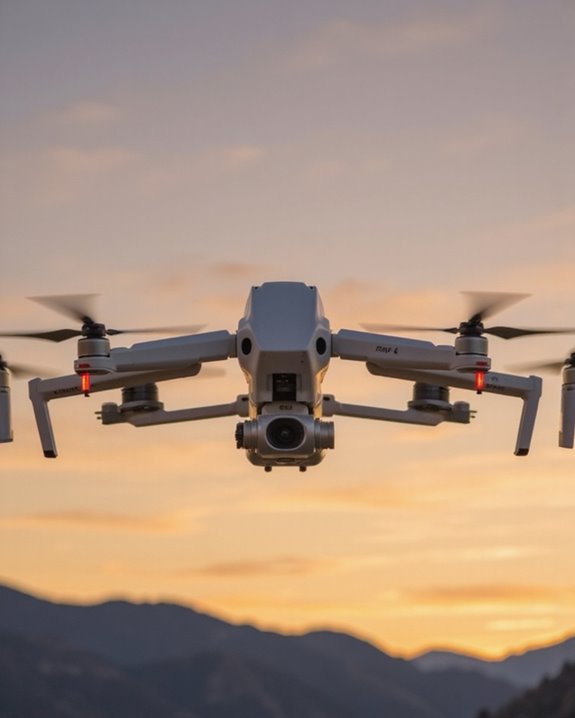The best unmanned aircraft for most drone enthusiasts include the DJI Mini series (under 250g, perfect for beginners!), DJI Mavic Air 2 (excellent balance of professional features and portability), and Autel EVO II (impressive 40-minute flight time with 8K camera). You’ll want to evaluate battery life, payload capacity, and weather resistance when making your selection. Don’t forget you’ll need proper FAA certification if flying commercially—the right drone makes all the difference in your aerial adventures!
Key Takeaways
- Professional drones like DJI Mavic series offer advanced capabilities for aerial photography, mapping, and commercial operations.
- Lightweight recreational drones under 250g, such as the DJI Mini series, are ideal for beginners and hobbyist pilots.
- Battery life ranges from 10-60 minutes per charge, with higher mAh ratings providing longer flight times for extended missions.
- Key selection factors include weight (under 55 pounds for FAA compliance), weather resistance, and safety features like return-to-home functionality.
- Payload capacity varies significantly between models, affecting what equipment can be carried and overall flight performance.
Remote Pilot sUAS Study Guide for Small Unmanned Aircraft Systems
- Federal Aviation Administration (FAA) (Author)
- English (Publication Language)
- 88 Pages - 10/31/2016 (Publication Date) - Aviation Supplies & Academics, Inc. (Publisher)
The Remote Pilot sUAS Study Guide is a must-have resource for anyone serious about flying drones legally and professionally. While it’s initially overwhelming, you’ll find it gets easier with time, just like flying itself!
Available free online through the FAA or in convenient paperback formats, this thorough guide covers everything you’ll need for your certification. Many pilots prefer the physical version for portability and note-taking — no power required!
Don’t underestimate the importance of proper study; flying might be easy, but mistakes can lead to serious consequences. Though somewhat dry, this well-thought-out guide simplifies technical topics and regulations, making it worth every minute you’ll spend with it.
Best For: Aspiring drone operators looking to obtain FAA remote pilot certification who want comprehensive study materials that cover all required test material and regulations.
Pros:
- Available for free online through the FAA website with physical paperback options for those who prefer tangible study materials
- Comprehensive guide that simplifies complex technical topics and regulations essential for certification
- Well-thought-out content that contains all necessary test material for remote pilot certification
Cons:
- Initially overwhelming for beginners with a steep learning curve
- Content is described as somewhat dry which may make studying challenging
- Mistakes in applying knowledge can have serious consequences including legal penalties
Remote Pilot Small Unmanned Aircraft Systems Study Guide (FAA-G-8082-22)
- Administration, Federal Aviation (Author)
- English (Publication Language)
- 79 Pages - 02/03/2019 (Publication Date) - Independently published (Publisher)
Designed specifically for commercial drone pilots pursuing FAA certification, Remote Pilot Small Unmanned Aircraft Systems Study Guide (FAA-G-8082-22) offers a thorough overview of regulations and operational knowledge needed for the Part 107 test. This official FAA publication covers everything from airspace rules to weather interpretation, making it a convenient resource for both study and post-certification reference.
While the content receives praise from instrument-rated pilots switching to drone work, be warned about the physical quality! Many users complain about the tiny font size and blurry diagrams that might have you reaching for a magnifying glass. You’ll likely want to supplement with additional study materials or enlarged printouts of key sections for effective exam preparation.
Best For: Commercial drone pilots seeking official FAA materials for Part 107 certification, especially those with prior aviation experience who need to understand regulations and operational requirements.
Pros:
- Comprehensive, official FAA content covering regulations, airspace rules, weather interpretation, and other essential knowledge for the Part 107 test
- Convenient resource that serves as both a study guide and post-certification reference material
- Reasonably priced printed version of information that would otherwise require finding and printing multiple FAA documents
Cons:
- Extremely small font size that strains eyes and may require magnification
- Diagrams, charts, and maps are often blurry, low-quality, or unreadable, especially those meant to be in color
- Not sufficient as a standalone study resource – requires supplementation with practice questions and additional materials for thorough test preparation
Remote Pilot Study Guide for Small Unmanned Aircraft Systems
- U.S. Department of Transportation (Author)
- English (Publication Language)
- 34 Pages - 12/01/2021 (Publication Date) - Independently published (Publisher)
Aspiring drone pilots seeking FAA certification will find mixed value in this Remote Pilot Study Guide, which receives particularly conflicting feedback from actual users. While some praise it as a “good purchase” for exam preparation, many others express significant disappointment with its content.
You’ll discover this isn’t a thorough study guide but rather a 27-page list of regulations without explanations—essentially just section numbers without the teaching you’ll need! The print format creates additional frustration, as the text appears too small when viewed on phones. Many users report they wouldn’t purchase it again, with some even returning it to find “actual teaching material.” Save yourself the trouble—all this information is readily available online for free!
Best For: Drone enthusiasts who prefer a basic, no-frills reference of FAA regulatory numbers but don’t need detailed explanations or comprehensive exam preparation.
Pros:
- Compact 27-page format provides a concise list of FAA regulations
- Some users found it helpful as a quick reference guide
- Inexpensive option compared to more comprehensive study materials
Cons:
- Lacks explanations of regulations, offering only section numbers without teaching content
- Poor formatting makes it difficult to read on mobile devices
- Most information contained in the guide is freely available online
Factors to Consider When Choosing an Unmanned Aircraft

When selecting your unmanned aircraft, you’ll need to weigh several essential factors that directly impact your flying experience and project success. Your decision should account for flight range capabilities, payload capacity options, legal certification requirements, battery life duration, and other technical specifications that match your specific needs. These considerations will help you avoid costly mistakes and guarantee you’re getting the right drone for the job, whether you’re capturing breathtaking aerial footage or conducting professional inspections!
5 Subheading Discussion Points
Why do some drone pilots soar to success while others struggle with disappointment? The answer often lies in how carefully they’ve selected their unmanned aircraft! When choosing your perfect drone companion, you’ll need to evaluate several critical factors that directly impact your flying experience.
First, consider your aircraft’s weight—drones under 55 pounds follow specific FAA regulations that make your life easier. Don’t overlook battery life and range, which determine how long your aerial adventures will last. Weather resistance is essential too, as wind and visibility can quickly ground an unprepared pilot.
You’ll want safety features like return-to-home functionality—trust me, this can save your investment when things go sideways! Finally, if you’re flying commercially, pay special attention to speed and altitude limitations. These considerations aren’t just bureaucratic hoops; they’re your pathway to drone piloting success!
Flight Range Capabilities
How far your drone can fly represents perhaps the most essential capability you’ll need to understand before making your purchase! While manufacturers love touting impressive maximum distances, the reality is often quite different. You’ll face regulatory constraints requiring visual line of sight operation, which typically limits your practical range to where you can actually see your aircraft.
Battery life, the unsung hero of drone specifications, directly determines your effective flight time. Those perfect conditions in the brochure? They rarely account for the headwind you’ll battle on the return trip! Your control signal strength, measured in kilometers, establishes your maximum reliable operating distance. Don’t forget that heavier payloads, like that fancy camera you’re eyeing, will reduce range by demanding more power. Plan accordingly, and you’ll avoid the dreaded “low battery” warning when you’re capturing that perfect shot!
Payload Capacity Options
The drone’s ability to lift additional weight determines everything you’ll actually accomplish with your unmanned aircraft! When selecting your perfect drone, you need to evaluate how much equipment it can carry without becoming a fancy paperweight. Payload capacities vary dramatically, from tiny micro-drones carrying just a few grams to professional models hefting several kilograms of equipment.
Legal Certification Requirements
Handling federal regulations might seem challenging, but your drone adventure depends on understanding these essential certification requirements! To fly commercially in the US, you’ll need to obtain your Remote Pilot Certificate by passing the FAA Part 107 knowledge test—no shortcuts here!
You must be at least 16 years old and comfortable with English to qualify. The test isn’t a walk in the park; it covers regulations, airspace classification, weather services, and emergency procedures. Don’t worry though, the preparation is worth it!
Once certified, you’re not off the hook. You’ll need to maintain visual line of sight during operations, avoid restricted airspace, and stay current with your knowledge. Let your certification lapse? Back to square one with retesting! A small price to pay for legal drone operations, wouldn’t you agree?
Battery Life Duration
Beyond legal requirements, battery life stands as one of your most important considerations when selecting the perfect unmanned aircraft! You’ll typically get between 10-60 minutes of flight time per charge, depending on your drone’s battery capacity and energy demands.
When reviewing specs, pay attention to the mAh rating—higher numbers generally mean longer flights, though they’ll add some extra weight. Don’t forget that real-world conditions dramatically affect performance! Cold temperatures and gusty winds can slash your expected flight time by up to 30%, turning that promised hour-long adventure into a brief 40-minute excursion.
Your flying style matters too. Those exciting maneuvers and payload operations might drain your battery twice as fast as gentle cruising, so choose a battery with energy density (150-250 Wh/kg) that matches your specific needs.
Frequently Asked Questions
How Do Recreational Drone Regulations Differ From Commercial Unmanned Aircraft Rules?
You’ll find recreational drone use has fewer regulations than commercial operations. As a hobbyist, you’re exempt from pilot certification and can fly for fun with basic registration, while commercial pilots need Part 107 certification, must maintain visual line-of-sight, and follow stricter operational limitations. Commercial flights require documentation, flight logs, and maintenance records too. The biggest difference? Commercial pilots can make money from their flights, but you can’t profit from recreational flying!
What Weather Conditions Make Flying Unmanned Aircraft Unsafe?
You should avoid flying your drone in several dangerous weather conditions. Strong winds can overpower your aircraft, while rain, snow, or fog impair visibility and may damage electronics. Lightning storms pose a serious electrocution risk, and extreme temperatures (both hot and cold) can affect battery performance. Sudden weather changes, like microbursts or approaching storm fronts, are particularly treacherous! Remember, even mild precipitation can interfere with sensors and camera equipment, so always check your local forecast before taking flight.
Can Unmanned Aircraft Be Equipped With Weapons?
Yes, unmanned aircraft can be equipped with weapons, though this capability is highly regulated. Military drones like the MQ-9 Reaper carry missiles and bombs for precision strikes, while civilian use of weaponized drones is illegal in most countries. You’ll find strict international laws governing these systems, and for good reason! The technology raises serious ethical concerns about remote warfare, civilian casualties, and the psychological distance between operator and target. The regulations you’ll encounter vary dramatically between military and civilian sectors.
Which Unmanned Aircraft Models Offer the Best Battery Life?
You’ll find impressive battery life in the DJI Mavic 3 with up to 46 minutes of flight time, perfect for capturing those extended aerial shots! The Autel EVO II offers around 40 minutes, while the military-grade MQ-9 Reaper can stay airborne for an astounding 14+ hours. For hobbyists, don’t overlook the Parrot Anafi with its 25-minute capability or the compact DJI Mini 3 Pro, which delivers about 34 minutes of adventure before needing a recharge.
How Do Anti-Drone Technologies Affect Unmanned Aircraft Operations?
Just when you thought your drone could fly freely, anti-drone technologies swoop in like overprotective parents at a teenage party! These systems can seriously impact your operations by jamming your control signals, GPS navigation, or even physically capturing your aircraft. You’ll face restricted flight zones, potential signal interference, and regulatory limitations in sensitive areas. To stay airborne, you’ll need to research local restrictions, invest in drone detection systems, and consider counter-jamming technologies before planning your flights!








